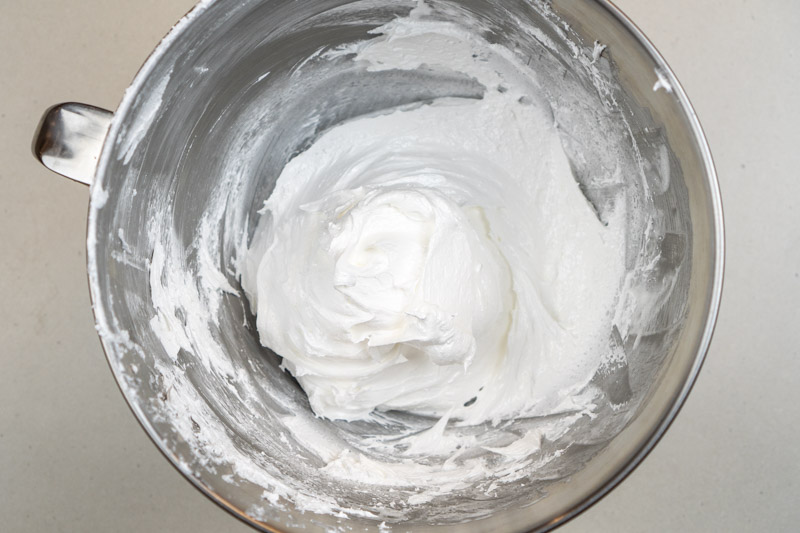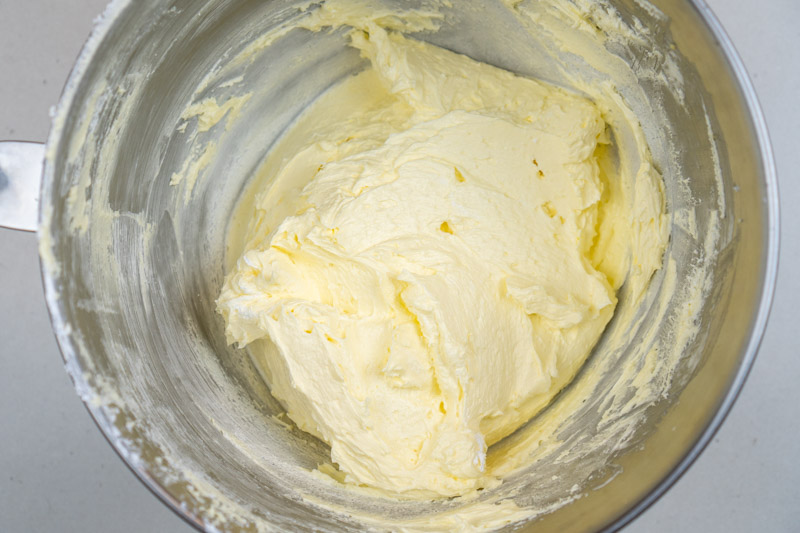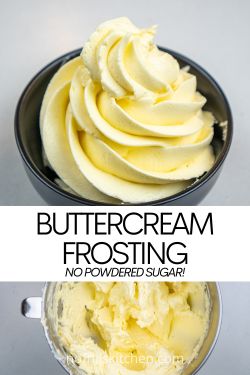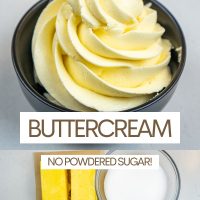I hate American buttercream – the kind that is simply butter and icing (powdered) sugar whipped together. I think it’s too sweet and I don’t particularly care for the grainy texture that icing sugar gives. Because of this, I almost always use this method of making buttercream – Swiss meringue – which uses no powdered sugar at all!
It’s slightly more technical and it definitely takes a bit longer than making an American buttercream, but it’s not fundamentally difficult. It also pipes beautifully, is more stable and is super glossy and delicious.

How to Make Buttercream Without Powdered Sugar
This recipe is easiest made in a stand mixer, but a good hand mixer and a large bowl will do if that’s all you’re working with.
Make sure your butter is at room temperature, it will incorporate much more easily if you do and prevent you from getting a curdled appearance.
If you’ve forgotten to soften your butter ahead of time, take it out of the fridge, cut it into pieces and put in on a plate at room temperature before you get started. By the time the meringue is done, your butter should be at the right temperature.

This recipe is also easiest if you have an instant-read thermometer. This way you can ensure that your egg whites have reached the proper temperature to be stable and pasteurised.
If you don’t have a thermometer and don’t care to purchase one (it’s an invaluable kitchen tool, so I highly recommend getting one), then use pasteurised egg whites – these are the ones that usually come in a carton at the supermarket.
Now, to get started, add some water to a large saucepan and bring it to a gentle simmer over low heat. In a large mixing bowl or the bowl of a stand mixer, whisk together some egg whites, sugar and a pinch of salt.
Set the bowl over the simmering water, ensuring the bottom of the bowl is not touching the water. Whisking constantly, heat the egg white mixture until it reaches 70°C/160°F on an instant-read thermometer – about 10 minutes.

If you don’t have a thermometer, simply heat the mixture until you cannot feel any sugar when you rub a little bit between your fingers.
This is the beginning of a Swiss meringue (and we’ve already covered Italian meringue in my marshmallow recipe, and the simplest – French meringue!).
Once the egg white mixture has come to the correct temperature, it’s time to whip the meringue. Using a stand mixer fitted with the whisk attachment or a hand mixer, whip on high until the meringue reaches stiff peaks and it has cooled completely to room temperature.

It is imperative that the meringue is at room temperature because any residual heat will melt the butter and collapse your buttercream. So make sure that you can’t feel any warmth on the outside of the bowl when it’s touched – and if you can, simply wait until you move to the next step.
Once your meringue is cool and stiff, it’s time to start adding your butter. One piece at a time, with the mixer running, add in your butter, making sure it’s fully incorporated before adding another piece.

Make sure you’re scraping down the sides of the bowl periodically to ensure that everything is fully incorporated.
Once the butter is added, switch to the paddle attachment if you’re using a stand mixer and stir in some vanilla extract.
Mix on medium for a minute or two, just to knock out some of the air bubbles and to smooth out the buttercream.

And that’s it! You can now use the buttercream to ice cupcakes, a layer cake or to pipe decoratively.

Buttercream Frosting Without Powdered Sugar
Equipment
Ingredients
- 100 g (3 ½ oz) egg whites from about 3 eggs
- 250 g (1 ¼ cups) caster sugar (see note 1)
- Pinch salt
- 500 g (1 lb) unsalted butter room temperature, cut into pieces
- 2 tsp vanilla extract (see note 5)
Instructions
- Add the egg whites, sugar and salt to a large, heatproof bowl (or the bowl of a stand mixer) and whisk to combine.
- Add some water to a large saucepan and bring to a very gentle simmer over low heat. Set the bowl with the egg whites over the saucepan, ensuring the water doesn't touch the bottom of the bowl. Whisking constantly, heat the egg white mixture until it reaches a temperature of 70°C/160°F on an instant-read thermometer – about 10 minutes (see note 2).

- Remove the egg whites from the heat. Using a stand mixer fitted with the whisk attachment or a hand mixer, whip the egg whites on high speed until they are glossy, reach stiff peaks and are completely room temperature (see note 3)

- Reduce the speed to medium and, one piece at a time, add in the butter, ensuring the piece is completely incorporated before adding in another piece. Continue until all the butter is incorporated (see note 4).

- If using a stand mixer, switch to the paddle attachment. Add the vanilla (see note 5) and mix on medium-low until incorporated and some of the air bubbles have been knocked out. The frosting is now ready to use (see note 8).

Notes
- I prefer using caster sugar (also known as superfine sugar) as it dissolves more easily. However, granulated sugar can easily be swapped with no ill effects – just note that it may take longer to dissolve into the egg whites.
- Heating the egg whites to this temperature pasteurises them and aids in the stability of the buttercream. If you don’t have a thermometer, simply heat the egg whites until you cannot feel any granules of sugar when the mixture is rubbed between your fingers. For this method, use pasteurised egg whites (generally found in a carton) if you’re concerned.
- For success in this recipe, it is imperative that the meringue is at room temperature, as the butter will melt if there is even a little bit of warmth left. If the meringue is at stiff peaks before it’s at room temperature, simply wait until it cools down before adding in the butter.
- If you’d like to make a chocolate buttercream, reduce the butter by 150g. Melt 150g of dark chocolate and stir it into the frosting once all of the butter has been incorporated.
- For flavour variations, swap the vanilla for any other flavour extract of your choice.
- To colour the buttercream, use any amount of gel food colouring (liquid food colouring will alter the consistency of the frosting) and add it in with the vanilla.
- This full recipe makes enough to frost a standard, 3-layer cake or about 24 cupcakes.
- The frosting, stored in an airtight container, will last for up to a week in the refrigerator. Let it come to room temperature before using. Frozen, it will last for up to 3 months.
Nutrition
Disclaimer: Nutritional information is automatically generated and provided as guidance only. Accuracy is not guaranteed.
Yes, this recipe is more complex than an American buttercream, but it’s also less sweet, more butter-forward and more stable. It also doesn’t use any icing sugar!
Are you after a buttercream frosting that doesn’t use powdered sugar? Have any questions? Let me know in the comments!










